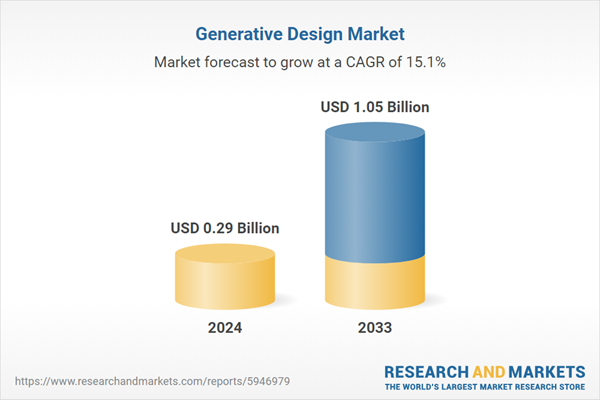The global generative design market size reached USD 297.8 Million in 2024. Looking forward, the publisher expects the market to reach USD 1.05 billion by 2033, exhibiting a growth rate (CAGR) of 14.31% during 2025-2033. The market is propelled by the rising demand for advanced design solutions, increasing adoption of artificial intelligence and machine learning technologies, growing emphasis on sustainability and resource efficiency in design procedures, integration of generative design with additive manufacturing, rapid growth in cloud-based generative design platforms, and expansion of the market beyond traditional industries.
Generative design is an engineering software that autonomously creates high-performance design iterations based on performance or spatial requirements, manufacturing methods, materials, and costs. It relies on artificial intelligence (AI) algorithms to generate and evaluate a wide range of product designs and make highly customized complex shapes and internal lattices that cannot be produced using conventional manufacturing methods. In addition, it supports topology optimization for performing structural simulation and removing load-weight from empty areas in three-dimensional (3D) models. At present, generative design is adopted around the world as it helps in reducing component weight and simplifying the design.
2. What is the expected growth rate of the global generative design market during 2025-2033?
3. What are the key factors driving the global generative design market?
4. What has been the impact of COVID-19 on the global generative design market?
5. What is the breakup of the global generative design market based on the component?
6. What is the breakup of the global generative design market based on the deployment model?
7. What is the breakup of the global generative design market based on the application?
8. What is the breakup of the global generative design market based on the industry vertical?
9. What are the key regions in the global generative design market?
10. Who are the key players/companies in the global generative design market?
Generative design is an engineering software that autonomously creates high-performance design iterations based on performance or spatial requirements, manufacturing methods, materials, and costs. It relies on artificial intelligence (AI) algorithms to generate and evaluate a wide range of product designs and make highly customized complex shapes and internal lattices that cannot be produced using conventional manufacturing methods. In addition, it supports topology optimization for performing structural simulation and removing load-weight from empty areas in three-dimensional (3D) models. At present, generative design is adopted around the world as it helps in reducing component weight and simplifying the design.
Generative Design Market Trends:
The growth in the market can be attributed to the extensive usage of generative design software in various end use industries around the world. For instance, it is employed in the automotive industry for manufacturing lightweight components and consolidating parts. This, in confluence with the boosting sales of passenger and commercial vehicles on account of rapid urbanization and improving income levels, is contributing to the market growth. Moreover, regulatory authorities in various countries are implementing stringent policies to reduce the ecological footprint of commercial aircraft. As a result, several manufacturers operating in the aerospace industry are relying on generative design software to reduce aircraft weight, minimize environmental impact, and improve passenger safety. Apart from this, the growing popularity of drones is driving the use of generative design software to improve their aerodynamic efficiency and durability and increase lifespan and flight performance. Other factors, such as the escalating demand for consumer goods and the thriving construction industry, are positively influencing the demand for generative design software to generate multiple computer-aided designs (CADs) and drive innovation and productivity.Generative Design Industry Segmentation:
The publisher provides an analysis of the key trends in each segment of the market, along with forecasts at the global, regional, and country levels for 2025-2033. Our report has categorized the market based on component, deployment model, application, and industry vertical.Breakup by Component:
- Software
- Services
Breakup by Deployment Model:
- On-premises
- Cloud-based
Breakup by Application:
- Product Design and Development
- Cost Optimization
- Others
Breakup by Industry Vertical:
- Automotive
- Aerospace and Defense
- Industrial Manufacturing
- Architecture and Construction
- Others
Breakup by Region:
- North America
- United States
- Canada
- Asia-Pacific
- China
- Japan
- India
- South Korea
- Australia
- Indonesia
- Others
- Europe
- Germany
- France
- United Kingdom
- Italy
- Spain
- Russia
- Others
- Latin America
- Brazil
- Mexico
- Others
- Middle East and Africa
Competitive Landscape:
The competitive landscape of the industry has also been examined along with the profiles of the key players being 3Dnatives, Altair Engineering Inc., Ansys Inc., Autodesk Inc., Bentley Systems Incorporated, Dassault Systèmes SE, Desktop Metal Inc., Diabatix, MSC Software Corporation (Hexagon AB), Ntopology Inc., Proto3000 Inc. and Ptc Inc.Key Questions Answered in This Report
1. What was the size of the global generative design market in 2024?2. What is the expected growth rate of the global generative design market during 2025-2033?
3. What are the key factors driving the global generative design market?
4. What has been the impact of COVID-19 on the global generative design market?
5. What is the breakup of the global generative design market based on the component?
6. What is the breakup of the global generative design market based on the deployment model?
7. What is the breakup of the global generative design market based on the application?
8. What is the breakup of the global generative design market based on the industry vertical?
9. What are the key regions in the global generative design market?
10. Who are the key players/companies in the global generative design market?
Table of Contents
1 Preface3 Executive Summary12 Value Chain Analysis14 Price Analysis
2 Scope and Methodology
4 Introduction
5 Global Generative Design Market
6 Market Breakup by Component
7 Market Breakup by Deployment Model
8 Market Breakup by Application
9 Market Breakup by Industry Vertical
10 Market Breakup by Region
11 SWOT Analysis
13 Porters Five Forces Analysis
15 Competitive Landscape
List of Figures
List of Tables
Companies Mentioned
- 3Dnatives
- Altair Engineering Inc.
- Ansys Inc.
- Autodesk Inc.
- Bentley Systems Incorporated
- Dassault Systèmes SE
- Desktop Metal Inc.
- Diabatix
- MSC Software Corporation (Hexagon AB)
- Ntopology Inc.
- Proto3000 Inc.
- Ptc Inc.
Methodology

LOADING...
Table Information
| Report Attribute | Details |
|---|---|
| No. of Pages | 142 |
| Published | January 2025 |
| Forecast Period | 2024 - 2033 |
| Estimated Market Value ( USD | $ 0.29 Billion |
| Forecasted Market Value ( USD | $ 1.05 Billion |
| Compound Annual Growth Rate | 15.1% |
| Regions Covered | Global |
| No. of Companies Mentioned | 12 |









